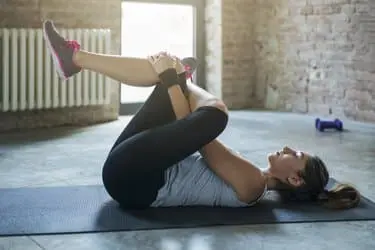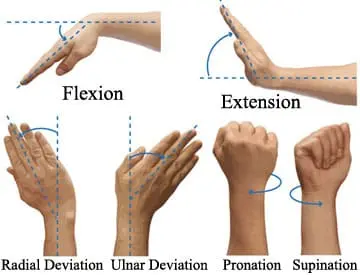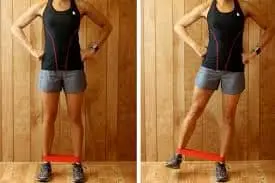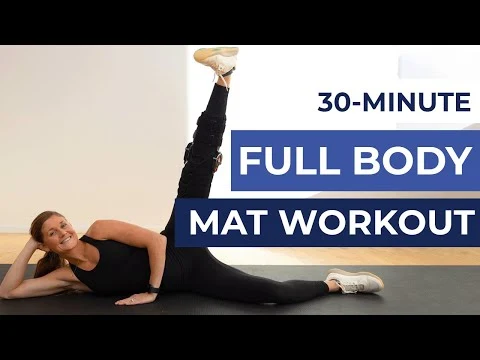10 Best Exercises for Lumbar Spondylolisthesis
Exercises for lumbar spondylolisthesis help to strengthen the muscles surrounding the spine, improve flexibility, and increase stability in the affected area.
To treat lumbar spondylolisthesis effectively, exercise therapy is essential. Patients with spondylolisthesis may find it hard to tell between a functioning and non-functioning spine, but understanding which activities might strengthen and correct the back muscle can be beneficial.
What is Lumbar Spondylolisthesis?
When a spinal segment misaligns and slips onto the bone above it, it causes lumbar spondylolisthesis. degeneration of the vertebrae or disc, trauma, fracture, or genetics can all cause this. The lower spine is typically affected.
Symptoms of Spondylolisthesis:
- Lower back pain
- Stiffness in the back
- Back pain or soreness that is localized immediately above the pelvic
- Referred Pain in the thighs and legs.
Exercise for Lumbar Spondylolisthesis:
After a thorough evaluation, your physical therapist will be able to provide you with a personalized home exercise plan to help alleviate the pain caused by spondylolisthesis.
Wall squats
- Place your feet shoulder-width apart and about two or three feet away from the wall, with your back against the wall at the beginning.
- Place your feet so that, instead of your knees being over your toes, they are clearly over your ankles.
- Maintain a flat back against the wall.
- Hold this position for a few seconds.
- Then return to your neutral position.
- Then relax.
- Repeat this exercise five to ten times.
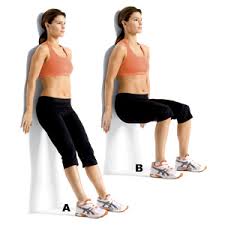
Side Plank
- Start by lying down on your side securely on the ground.
- As long as your elbow is properly behind your shoulder, use your forearm to help you stand.
- Elevate yourself off the floor by supporting your weight with your forearm.
- Hold this position for a few seconds.
- Then return to your neutral position.
- Then relax.
- Repeat this exercise five to ten times.

Bridging
- On your back, lie comfortably.
- Perhaps practice this on a yoga mat or some other cushioned surface.
- Lift your hips off the ground by pushing through your feet while keeping your knees bent and your feet flat on the ground.
- At the peak of the exercise, tighten your butt muscles.
- Hold this position for a few seconds.
- Then return to your neutral position.
- Then relax.
- Repeat this exercise five to ten times.
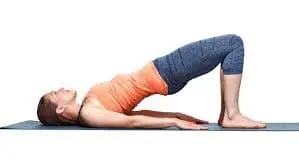
Dead bug
- Laying on your back, stretch both arms toward the ceiling to start.
- Raise your legs to a 90-degree angle from the floor.
- Try to push your back against the floor by turning your pelvis upward and engaging your core muscles as you exhale to lower your rib cage.
- To start the exercise, extend your left leg, straighten it at the hip and knee, and lower it to a small height over the floor.
- Hold this position for a few seconds.
- Keeping your abdominal and gluteal muscles taut, move your left leg and right arm to the initial position.
- Proceed with your right leg and left arm next.
- Then relax.
- Repeat this exercise five to ten times.
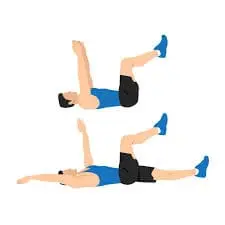
Hamstring stretch
Patients with spondylolisthesis often have tight hamstrings, which are the big muscles that run down the back of the legs, as a result of their unstable spines. Tight hamstrings can lead to lower back pain and stiffness.
- Put your feet pointing up and sit on the floor with your legs out in front of you.
- Bend forward slowly and touch your toes.
- Simply reach until you feel a stretch along the back of your legs, and don’t worry if you can’t touch your feet.
- Hold this position for a few seconds.
- Then return to your neutral position.
- Then relax.
- Repeat this exercise five to ten times.
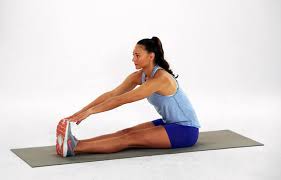
Double knee to chest
Strengthening the deep core muscles in the abdomen could help reduce instability and alleviate spondylolisthesis pain.
- With your feet flat on the floor and your knees bent, begin by lying face up.
- Pulling your belly button to the floor will help you contract your stomach muscles.
- Bring both knees up to the chest with the help of your hands.
- Hold this position for a few seconds.
- Then return to your neutral position.
- Then relax.
- Repeat this exercise five to ten times.
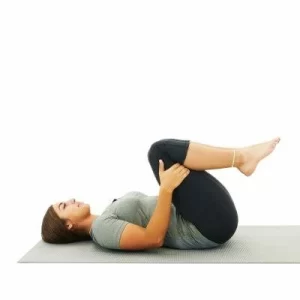
Pelvic tilt
By stabilizing the lumbar spine in a flexed position, this exercise helps to lessen pain. Positions used for this exercise vary based on the patient’s choice and level of pain.
- Bend your knees and lie on your back.
- Contract the muscles in your abdomen and press your lower back down toward the ground.
- Hold this position for a few seconds.
- Then return to your neutral position.
- Then relax.
- Repeat this exercise five to ten times.
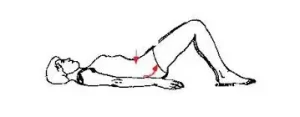
Crunch
- Begin in a comfortable lying down position on the floor.
- Then bend your knees.
- Now your arms crossed over your chest.
- If required, place your fingers behind your ears to support your head.
- However, avoid pulling on your head during this exercise.
- Gradually raise your head and shoulders off the ground until you feel your abs contract.
- Hold this position for a few seconds.
- Then return to your neutral position.
- Then relax.
- Repeat this exercise five to ten times.
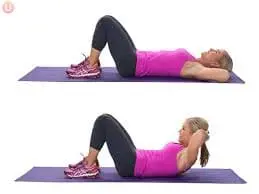
Gluteal stretch
- Initially, take a lying down position with both knees bent.
- Next, place one leg’s ankle on the other’s knee.
- Then, grasp the lower leg’s thigh and pull it towards your chest until you experience a stretch in your lower back and maybe your outer hip.
- Hold this position for a few seconds.
- Then return to your neutral position.
- Then relax.
- Repeat this exercise five to ten times.
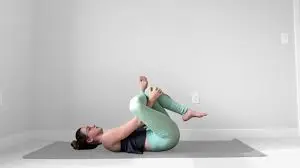
Multifidus activation
Your spine is in close proximity to the tiny yet crucial multifidus muscles. In addition to improving spinal joint stability, they help in twisting and turning movements.
- While resting on your side, move your top hand around to feel the vertebrae in your lower back.
- Your fingers should eventually slide into the space next to your spine if you slowly move them that way.
- To start engaging your core muscles, consider bringing your thigh to your chest while maintaining a straight leg.
- The muscle called multifidus will expand under your fingertips as a result of this compression.
- Hold this position for a few seconds.
- Then return to your neutral position.
- Then relax.
- Repeat this exercise five to ten times.
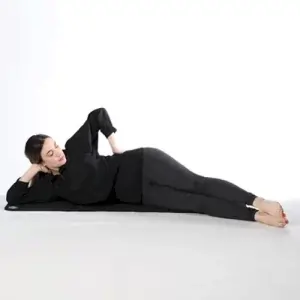
When exercising, what safety precautions should be taken?
- Make sure you maintain proper posture when performing the activity.
- Avoid challenging exercise programs.
- Stay away from uncomfortable exercises.
- Stop working out if you feel an unexpected soreness.
- In between exercise sets, take a rest.
- When exercising, dress comfortably to allow for maximum movement.
- If you have stiff muscles, stretch them out; nevertheless, it should never hurt too much.
When did you stop doing these exercises?
- You are ill.
- If it hurts, don’t exercise.
- A blurry view
- Fever
- Headache
Exercises to Stay Away of When Spondylolisthesis:
If you have spondylolisthesis, which makes your spine prone to injury, you may need to stop performing exercises that produce extra strain on the back. Before doing more damage to your spine or back, it’s important to speak with your doctor about your specific situation.
Here are some exercises to prevent spondylolisthesis;
- Exercises that require jerky or rapid movements should be avoided.
- Exercises that force you to twist or bend too much, such as toe touches, should be avoided even if they can help strengthen your back and abdominal muscles in the event of spondylolisthesis. This could cause more damage to your spine and worsen your pain.
- High-impact exercises: While maintaining an active lifestyle is essential for recovering from spondylolisthesis, avoiding any exercises that could strain your back is best in sports like football, basketball, running, etc.
- Heavy lifting: Lifting weights can stress your spine, especially if you don’t use good technique. As you lift something, your back gets more stressed, especially in the lower back (lumbar region).
Summary:
Worldwide, a large number of people suffer from lumbar spondylolisthesis. Because of aging naturally and the resulting wear and strain on the lower back’s discs and joints, it is rather common.
Thankfully, lumbarspondylolisthesis can be relieved and general back strength can be increased with physical therapy exercises.
FAQ:
What kind of exercise is ideal for people with spondylolisthesis?
Low-impact exercise is the ideal kind for those with spondylolisthesis. Because it doesn’t put unnecessary strain on the spine, low-impact exercises like walking and water aerobics are ideal for treating spondylolisthesis. Exercises such as this one encourage circulation and mobility without straining the spine.
Which exercise is most beneficial for lumbar spondylosis?
Pelvic tilt.
Cat-cow stretch.
Bridge pose.
Hamstring stretch
Does walking help people with lumbar spondylolisthesis?
For those who have spondylolisthesis, walking is typically advised since it keeps your muscles and joints flexible without putting undue strain on your lower back. Walk for five to ten minutes each day, maintaining a neutral spine and shoulders that are relaxed.
Which sleeping posture is ideal for individuals with spondylolisthesis?
Your spine may experience less strain when you sleep since your legs are kept at an angle with your body. Using pillows to keep your body up, you can try this sleeping posture. If it helps, you might want to look into getting an adjustable bed.
Does plank help with spondylolisthesis?
The ability to correctly support your spine is important for unloading the injured area, regardless of the type of spondylolisthesis you have.
Does spondylolisthesis benefit from bed rest?
Pain relief may be experienced by spondylolisthesis sufferers after one to two days of bed rest. Extended periods of bed rest worsen back pain by weakening the core muscles and increasing stiffness, further delaying recovery. Selecting a comfortable sleeping position and using a medium-sized mattress are recommended.
Is it possible to treat lumbar spondylolisthesis?
Long-term pain relief is possible with nonsurgical therapies, even though they cannot undo a slip or crack. Surgery can help with pain relief, strength restoration, and vertebral stability.
Which exercises worsen spondylolisthesis?
Sports and activities that put a strain on your spine should be avoided if you have spondylolisthesis and are experiencing symptoms, particularly pain. Strain from lifting weights, backbends, and intense rushing or jumping can all contribute to this.
Does spondylolisthesis worsen with sitting?
Your condition will certainly get worse if you spend hours sitting on a chair that isn’t supportive or adjustable. Since these chairs aren’t made to support your spine, you might find yourself reclining and bending forward as you try to get comfortable.
Does spondylolisthesis benefit from yoga?
Low-impact yoga poses serve to improve flexibility, strengthen the muscles supporting the spine, and lower stress levels. Not every yoga pose, meanwhile, is suitable for people who have spondylolisthesis. Certain positions may worsen the illness and injure the spine even more.
When I have spondylolisthesis, which position should I avoid?
On the other hand, sitting might exacerbate pain in those with spondylolisthesis. The main symptom of spondylolisthesis pain is typically a twisted, bent, or slumped sitting posture.
What happens if spondylolisthesis is not treated?
Teenage back pain is frequently caused by spondylolisthesis. During a growth spurt during puberty, many teenagers encounter symptoms. In the case that spondylolisthesis care is not received, long-lasting lower back pain or spinal deformity may result.
References:
- On March 5, 2019, Freutel, N. Exercises for Pain Relief from Spondylolisthesis. healthline.com/health/fitness-exercise/exercises-for-spondylolisthesis#takeaway
- Pietro Tirgar (2023c), December 13. Best Twelve Lumbar Spondylolisthesis Activities – Mobile Physiotherapy. Mobile Clinic for Physiotherapy. What is the best exercise for lumbar spondylolisthesis? https://mobilephysiotherapyclinic.in/#google_vignette
- Top Spondylolisthesis Exercises. Sept. 24, 2023. Web Medical. What are the best exercises for spondylolisthesis in people with back pain?
- J. P. P. Momt (2024, January 8). Five Easy and Safe Spondylolisthesis Exercises to Reduce Pain Quickly! Safe spondylolisthesis exercises to reduce discomfort are provided by Petersen Physical Therapy.
- Image 10, Workout at Global Health Spine and Laser Center (n.d.). Multifidus Activation Exercise: https://ghspineandlasercentre.com

